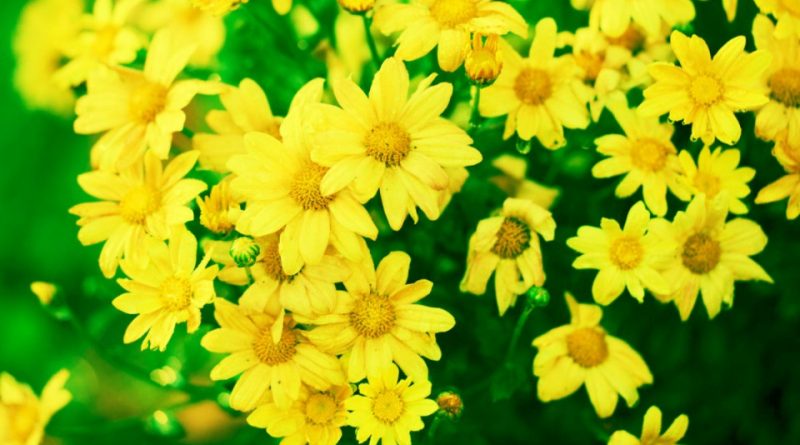Chrysanthellum americanum
Chrysanthellum americanum
The Golden Chrysanthemum (Chrysanthellum americanum (L.) Vatke, 1885) is a herbaceous species belonging to the Asteraceae family.
Systematics –
From the systematic point of view it belongs to the Eukaryota Domain, Kingdom Plantae, Magnoliophyta Division, Magnoliopsida Class, Subclass Asteridae, Asterales Order, Asteraceae Family, Asteroideae Subfamily, Heliantheae Tribe, Coreopsidinae Sub-tribe and therefore to the Chrysanthellum Genus and to the C. americanum Species.
The terms are synonymous:
– Anthemis americana L .;
– Bidens apiifolia L .;
– Chrysanthellina fasciculata Cass .;
– Chrysanthellina gracilis Cass .;
– Chrysanthellina swartzii Cass .;
– Chrysanthellum procumbens A.Rich .;
– Chrysanthellum procumbens Rich. ex Pers .;
– Verbesina mutica L .;
– Wedelia puberula DC ..
Etymology –
The term Chrysanthellum comes from Chrysanthemum, in turn from the Greek χρυσόϛ chrysόs gold and ἄνθεμον ánthemon fiore: golden flower, reference to the original type species and from the diminutive ellum.
The specific epithet americanum as it originates from the Americas (Northern, Central and Southern): American.
Geographic Distribution and Habitat –
Chrysanthellum americanum is a plant native to Peru and Bolivia and grows in tropical and subtropical environments of Africa, North America and Central America, where it prefers low-altitude, dried-up habitats of lake bottoms and puddles.
Description –
Chrysanthellum americanum is an annual herbaceous plant with a prostrate or decumbent habit.
Small herbaceous plant, creeping or barely erect, with alternating leaves that are deep pinnatosette and few in number, with long petioles; the basal ones form a rosette especially in young subjects, are divided into 3-5 deep lobes, each lobe being able to be subdivided in turn; they also have a large median rib and a thin tip at the tip.
The fruit is a flattened columnar achene, 2–3 mm long, with (2) 3 striae and abaxial and adaxial protrusions; achenes discal linear-oblong, 2–3 mm long, flattened, with marginated, fleshy and ciliated sides.
Cultivation –
The golden chrysanthemum is found mainly in mountainous places but also on African highlands and savannah. Near ruins, uncultivated places, abandoned roads and near shallow pools of water. It prefers siliceous or laterite soils. Its vegetative cycle is linked to the rainy season.
Customs and Traditions –
The Golden Chrysanthemum, also known as American Chrysanthemum, Golden Chamomile is a plant that contains the following active ingredients: flavonoids derived from Auron, chalcone and flavones, of the polyphenolic type, saponosides (chrysanthemum A and B derived from echinocystic acid and caulofilogenina).
In folk medicine it is used as a bitter, hepatoprotective, lipid-lowering tonic, provides vitamin P and is anti-inflammatory. Traditionally, this plant was used in cases of liver cirrhosis, hepatitis, intoxication, biliary, salivary and urinary calculi, gout, hemorrhoids, varicose veins, etc.
In general, therefore, it is used in herbal medicine thanks to its countless beneficial properties. The part that is generally used is its flowered top.
In phytotherapy it is useful in cases where, for example, you suffer from biliary, salivary and kidney stones, hepatitis, cirrhosis, dyslipidemia, hypercholesterolemia, hemorrhoids, hypertriglyceridemia, atherosclerosis, microcirculatory disorders, gout, capillary fragility, poor digestion, etc.
In summary, Chrysanthellum americanum performs the following functions:
– the anti-edematous and vaso-protective function;
– promotes microcirculation;
– improves peripheral spraying;
– anti-inflammatory action;
– activates the adrenal glands.
As for the possible contraindications, please note that it can cause heartburn, migraines and headaches in general. It is not recommended during pregnancy and breastfeeding, contraindicated in patients suffering from gastritis and peptic ulcers.
Preparation Method –
Chrysanthellum americanum uses the leaves, fruits and flowering tops. It can be prepared as a decoction-infusion of flowering tops: 4 g per cup of cold water, boil for 5 min and leave to infuse for another 5 minutes.
In herbal medicine it is used for the creation of products and supplements.
Guido Bissanti
Sources
– Acta Plantarum – Flora of the Italian Regions.
– Wikipedia, the free encyclopedia.
– Treben M., 2000. Health from the Lord’s Pharmacy, Advice and experiences with medicinal herbs, Ennsthaler Editore
– Pignatti S., 1982. Flora of Italy, Edagricole, Bologna.
– Conti F., Abbate G., Alessandrini A., Blasi C. (edited by), 2005. An annotated checklist of the Italian vascular flora, Palombi Editore.
Warning: Pharmaceutical applications and alimurgical uses are indicated for informational purposes only, they do not represent in any way a medical prescription; therefore no responsibility is taken for their use for curative, aesthetic or food purposes.


